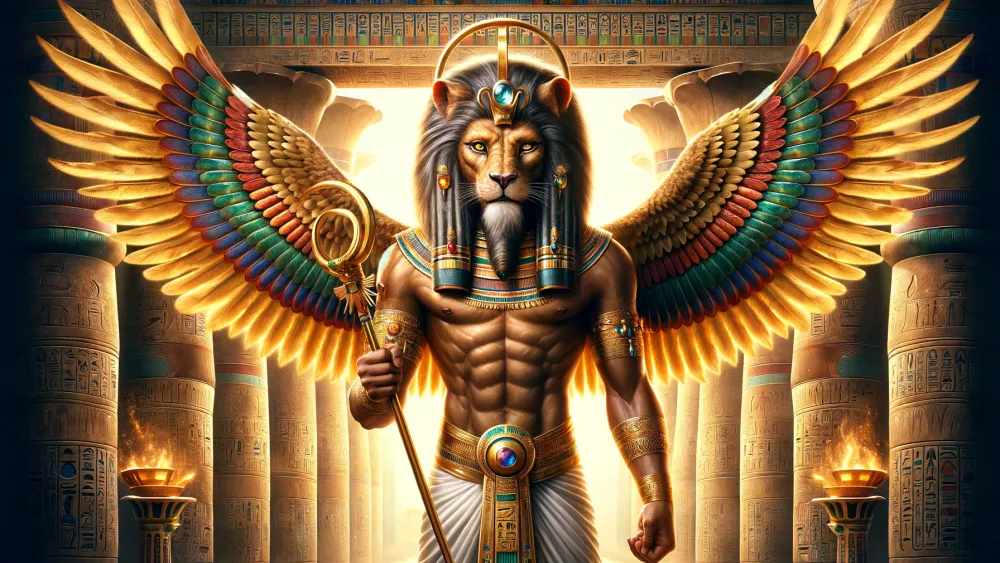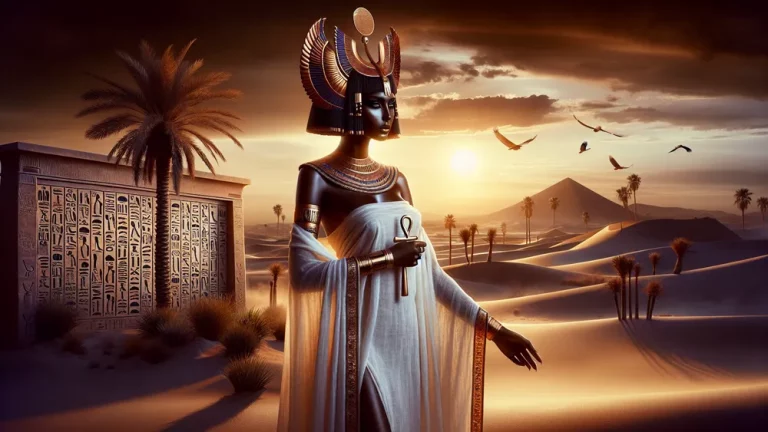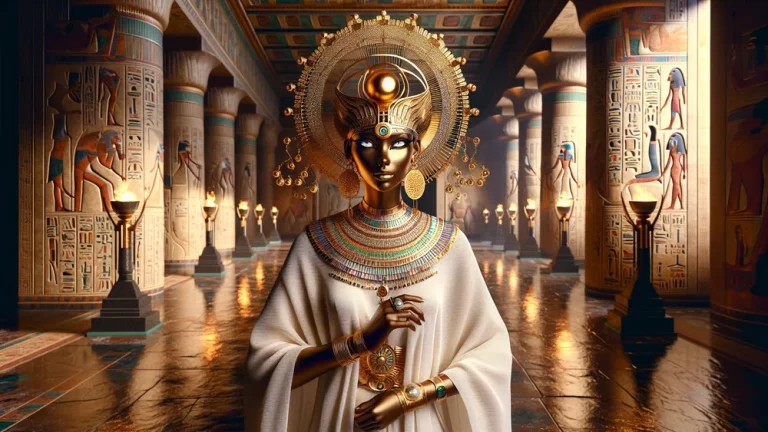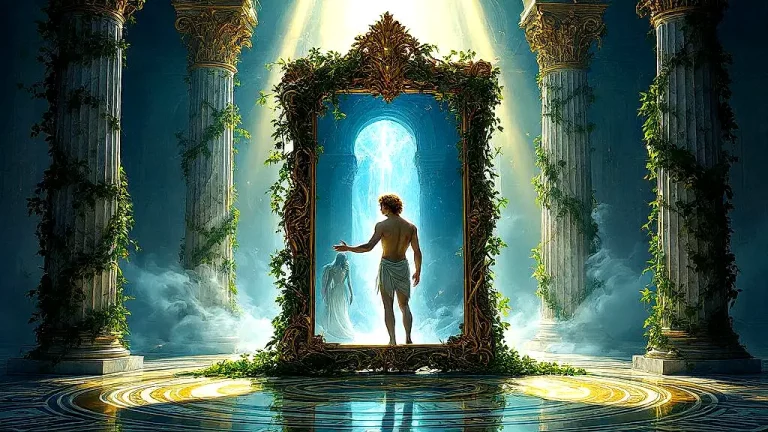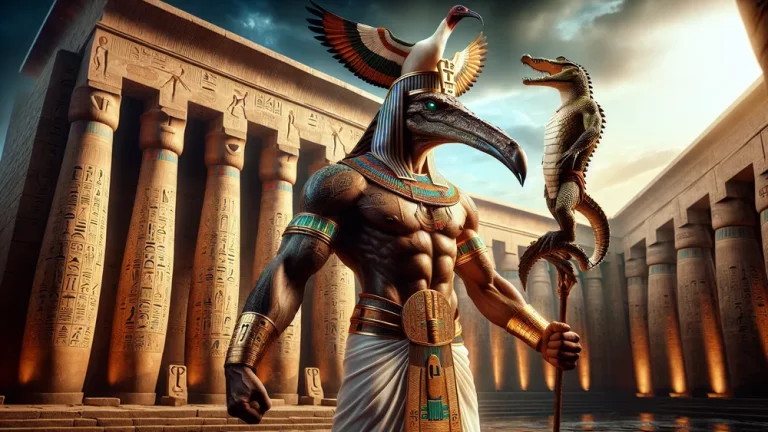Egyptian God Tutu: Master Of Fate And Fortune
Tutu is a really interesting god. Often shown as a sphinx, Tutu is seen as a master of fate and luck. He has both protective and destructive powers. This blog post dives into the story of Tutu, looking at his beginnings, symbols, roles, and how people worship him.
Key Points:
- Tutu is an ancient Egyptian god known as a master of fate and fortune and is often shown as a sphinx.
- His symbols include the sphinx, lion, serpent, and protective amulets, representing his roles and powers.
- Tutu was worshipped through rituals, prayers, and offerings in temples and shrines, especially during the Late Period and Ptolemaic times.
- He is a protector of dreams and a slayer of demons, bringing peace and security to those who seek his protection.
- Tutu’s modern depictions in books, movies, and games portray him as a mystical and protective figure, keeping his legacy alive.
- Academic research on Tutu reveals new understandings of his role in Egyptian mythology and his significance as a guardian and master of fate.
By checking out old texts, art pieces, and modern takes on him, we aim to show why Tutu still matters today. Given that he is part of the rich group of Egyptian gods, his story is worth knowing.
Tutu: Overview and Key Facts
| Aspect | Details |
|---|---|
| Name | Tutu |
| Depiction | Often shown as a sphinx with a lion’s body and a human head |
| Role | Master of fate and luck, protector of dreams, slayer of demons |
| Symbols | Sphinx, lion, serpent, and protective amulets |
| Origins | Shows up during the Late Period of ancient Egypt |
| Cultural Influence | Influenced by both Egyptian and Greek cultures, especially during the Ptolemaics |
| Worship Practices | Rituals, prayers, and offerings in temples and shrines |
| Key Temples | Temples in Thebes and other big Egyptian cities |
| Historical Periods | Late Period, Ptolemaics, possibly earlier mentions in old texts |
| Modern Depictions | Appears in books, movies, games; often as a mystical or protective figure |
| Academic Research | Studied for his special role and cross-cultural importance |
| Significance | Represents balance of protection/destruction; fate/fortune |
This table gives you a detailed look at Tutu. It covers his depiction, roles, symbols, origins. Also includes cultural influence because it’s important. Worship practices are listed too. You can find key temples where he was worshipped. Historical periods show when he was popular. Modern depictions tell how he’s seen today. Academic research highlights why scholars study him so much. And finally significance shows why he matters even now.
The Origins of Tutu
To understand Tutu’s story, we need to see where he comes from. For instance, let’s dive into his origins and find out how he becomes so important.
Historical Background of Tutu
The earliest mentions of Tutu show up in ancient Egyptian texts from the Late Period (around 664-332 BCE). These texts often call him a protective deity, especially for dreams and night-time dangers. For instance, people invoke Tutu in magical spells and amulets to keep away evil spirits. Given that ancient Egypt loves dream interpretation, Tutu’s role as a dream guardian becomes very important.
At the same time, his look as a sphinx (a creature with a lion’s body and human head) shows his mix of protection and power. Tutu appears during big cultural and religious changes in Egypt. While the Late Period sees foreign powers like Assyrians and Persians, it also brings back old Egyptian religious practices.
Consequently, Tutu’s worship mixes old beliefs with new ones. In particular, his job as a protector fits well with Egypt’s focus on safety in life and afterlife. Important times that shape how people worship Tutu include the Late Period, Ptolemaics (when Greek culture blends with Egyptian traditions), and possibly earlier times when local gods start gaining fame.
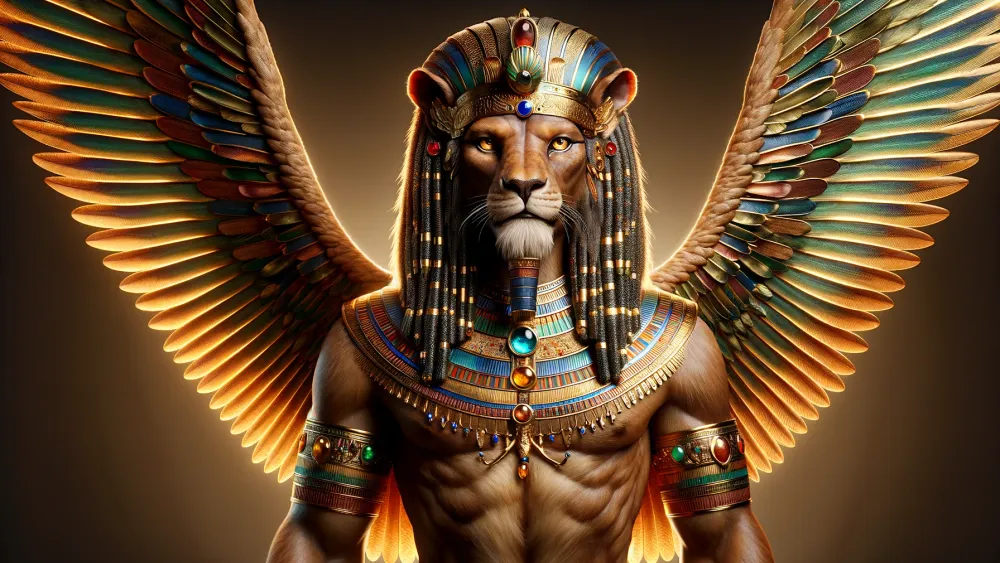
For example, during the Ptolemaics, Tutu’s image changes to add Greek elements, making him more popular.
Key Historical Periods:
- Late Period (664-332 BCE)
- Ptolemaics (305-30 BCE)
- Earlier mentions possibly in local gods’ worship
These periods shape how people see and worship Tutu, showing how flexible ancient Egyptian religion is.
Tutu in the Ptolemaics
During the Ptolemaics, Tutu’s look and role change a lot compared to earlier times. For instance, before this period, Tutu usually appears as a sphinx with a lion’s body and human head. Meanwhile, during the Ptolemaics, his image starts to show more Greek features like a more human-like face and possibly even Greek clothes. As for his role, it grows from just protecting dreams to also influencing fate and fortune.
| Aspect | Earlier Periods | Ptolemaics |
|---|---|---|
| Depiction | Sphinx with lion’s body, human head | Sphinx with Greek features, possibly Greek clothes |
| Role | Protector of dreams, night-time guardian | Protector and influencer of fate |
| Symbols | Lion, serpent, protective amulets | Same symbols plus Greek influences |
Greek influence really changes how people see Tutu. Given that the Ptolemaics mix Greek and Egyptian cultures together, Tutu’s image adapts to fit both traditions. Greeks often view sphinxes as guardians or riddlers. So Tutu’s job as a protector becomes even bigger. His power over fate fits well with Greek ideas about destiny too. This mix makes him more complex.
Tutu joins the larger pantheon during this time showing how flexible ancient Egyptian religion is. He starts out local but eventually becomes part of both Egyptian-Greek worship practices. Temples for him pop up next to those for other big gods now too.
Iconography and Symbolism
Given that Tutu’s look changes over time, let’s see how his iconography and symbols show his roles and powers.
Depictions of Tutu as a Sphinx
Tutu often appears as a sphinx, which means he has a lion’s body and a human head. For instance, in many ancient Egyptian artworks, Tutu’s face looks calm and wise, while his lion body shows strength and protection. At the same time, he sometimes has other features like wings or a serpent’s tail, adding to his mystical look.
These artistic choices highlight his role as both guardian and powerful being. The symbolic meanings behind these depictions are rich and varied. Given that the lion stands for strength and courage, Tutu’s lion body shows his power to protect and fight off evil. Meanwhile, his human head symbolizes intelligence and wisdom, making him a thoughtful protector.
In particular, the addition of wings or a serpent’s tail can mean he moves between worlds (like the human and divine realms). Consequently, these elements together make Tutu a complex figure who embodies both physical strength and mental sharpness.

Symbols Associated with Tutu
Tutu is linked to several main symbols and attributes. For instance, the lion, serpent, and protective amulets are often tied to him. At the same time, he sometimes has wings and a human head in depictions. These symbols help define his roles and powers in ancient Egyptian mythology.
- Lion: Shows strength and courage.
- Serpent: Stands for protection and rebirth.
- Protective amulets: Ward off evil forces.
- Wings: Let him move between realms.
- Human head: Means intelligence and wisdom.
The lion shows strength and courage, highlighting Tutu’s power to protect and fight off evil.
Meanwhile, the serpent stands for protection and rebirth, showing his role in guarding against harmful forces. In particular, protective amulets ward off evil forces, emphasizing his job as a guardian. Furthermore, wings let him move between realms (like human and divine worlds), making him versatile.
As for the human head, it means intelligence and wisdom, proving that Tutu is not only strong but also smart.
Tutu’s symbols like the lion for strength and courage and the human head for intelligence and wisdom define his powers and roles in Egyptian mythology.
Roles and Functions of Tutu
Given that Tutu’s symbols show his powers, let’s dive into his roles. For instance, he acts as both a protector and a demon slayer.
Protector of Dreams and Spirit Master
Tutu plays a key role as a guardian of dreams and a spiritual protector. For instance, ancient Egyptians believe Tutu wards off nightmares and evil spirits that disturb sleep. At the same time, he guides souls in the afterlife, ensuring they reach their destination safely. Given that dreams are messages from the gods, Tutu’s role in protecting these dreams is crucial.
Consequently, his presence brings peace and security to those who seek his protection. Rituals and prayers dedicated to Tutu are common practices for those seeking his protection. For example, people place protective amulets (often depicting Tutu) under their pillows to guard against bad dreams. Meanwhile, special prayers and offerings are made at shrines and temples to invoke his protective powers.
In particular, these rituals often include reciting specific incantations and offering food or small tokens. As a result, these practices help individuals feel safe and connected to the divine, knowing that Tutu watches over them.
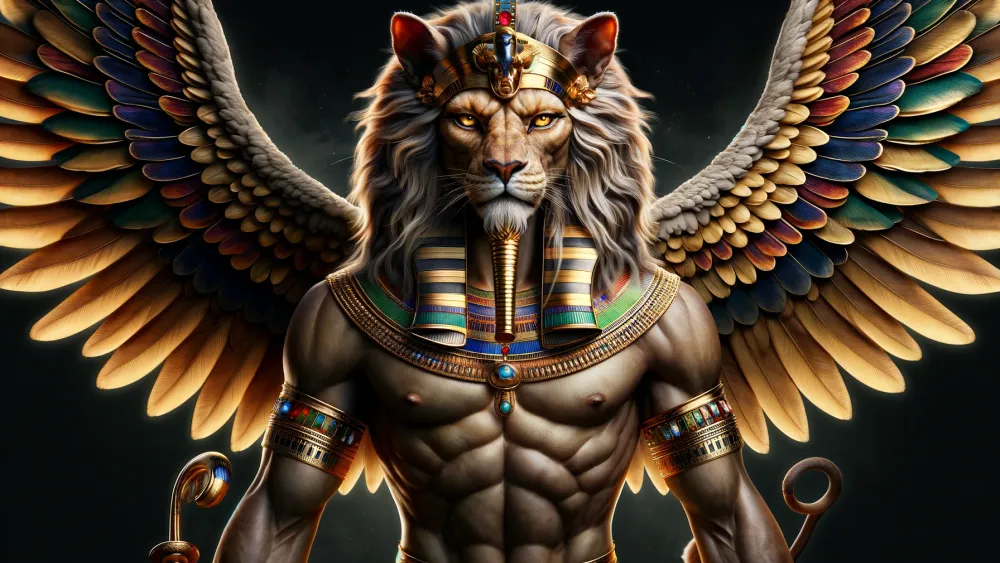
Tutu as a Demon Slayer
Tutu acts as a powerful slayer of demons and evil spirits. For instance, ancient Egyptians believe he defeats malevolent entities that threaten both the living and the dead. At the same time, Tutu’s role in fighting demons makes him key to keeping cosmic order. Given that demons are chaotic forces, Tutu’s ability to beat them ensures balance and harmony.
Consequently, people rely on Tutu for protection against these dark forces. Several myths highlight Tutu’s skill in defeating evil beings. For example, one story tells of Tutu battling a serpent demon terrorizing a village. Eventually, Tutu overcomes the demon, bringing peace back to the area. In another tale, Tutu faces a night demon preying on sleeping children.
Despite its terrifying power, Tutu wins, protecting the kids. As for these stories, they show not only his strength but also his role as a protector against evil.

Worship and Cult Practices
Given that Tutu plays such a key role, it’s no surprise his worship involves special rituals. As for how people venerate him, let’s explore further.
Temples and Shrines Dedicated to Tutu
Several key temples and shrines venerate Tutu. For instance, the Temple of Tutu in Kellis (an ancient village in Egypt) stands out as a special site. In particular, this temple features inscriptions and reliefs dedicated to Tutu, showing his importance. Meanwhile, smaller shrines across Egypt also honor him, often found in homes or local spots.
As for these shrines, they serve as places where people offer prayers and seek protection. The architectural and artistic features of these sacred sites are noteworthy. For example, the Temple of Tutu in Kellis shows intricate carvings and statues depicting Tutu as a sphinx.
At the same time, the walls have scenes of Tutu battling demons, highlighting his role as a protector. Given that these sites are places of worship, they often include altars for offerings and prayers. Consequently, the design and art of these temples reflect Tutu’s powerful nature.
Tutu is highly venerated and honored in various temples and shrines across Egypt, which showcase his significance through detailed inscriptions and artistic portrayals.
Rituals and Offerings
Common rituals and offerings to Tutu include various acts of devotion. For instance, people often leave food, drink, and small statues at his shrines. In particular, bread, beer, and incense are popular offerings. At the same time, special amulets with Tutu’s image are worn for protection. Meanwhile, rituals involve prayers and chants asking for Tutu’s help in guarding against evil spirits.
As for special occasions, festivals dedicated to Tutu include processions and communal prayers. The purpose and significance of these practices in ancient Egyptian religion run deep. Given that Tutu is seen as a protector, offerings aim to gain his favor and protection. For example, leaving food symbolizes sustenance for Tutu so he stays strong to fight off demons. Consequently, these acts help maintain cosmic balance and personal safety.
Furthermore, wearing amulets with Tutu’s image serves as a constant reminder of his protective presence. In particular, these practices show how people seek divine help in everyday life. Common offerings to Tutu:
- Bread
- Beer
- Incense
- Small statues
- Amulets
Offerings and rituals for Tutu, like leaving food and wearing amulets, seek divine protection and maintain balance for personal safety and cosmic harmony.
Tutu in Modern Culture
Even though Tutu’s roots are ancient, his influence continues today. As a result, let’s see how Tutu appears in modern times.
Tutu in Contemporary Media
Tutu shows up in modern books, movies, and games. For instance, some fantasy novels feature Tutu as a mystical guardian or powerful deity. Meanwhile, movies often show Tutu as a sphinx-like creature, mixing old myths with new stories. At the same time, video games include Tutu as a character with special powers linked to protection and fate.
Given that these portrayals mix ancient and modern elements, they introduce Tutu to new audiences in creative ways. The impact of these portrayals on public perception of Tutu is huge. In particular, they help people see Tutu’s role as a protector and master of fate. Consequently, he becomes more than just an old figure; he turns into a relatable character in today’s stories.

Furthermore, these portrayals often highlight his symbolic meanings, like guarding against evil. As a result, people gain deeper appreciation for his place in mythology and culture. Even though these modern depictions vary, they all keep his legacy alive.
Academic Studies and Research on Tutu
Recent research on Tutu uncovers new insights into his role in Egyptian mythology. For instance, scholars find texts that describe Tutu’s job as a protector of dreams and demon slayer. Meanwhile, archaeological finds (like temple inscriptions) give more context about his worship and rituals. At the same time, studies look at Tutu’s images, showing how his sphinx form means protection.
Given that these findings come from many sources, they offer a full view of Tutu’s importance. Key scholars add a lot to studying Tutu. In particular, Dr. Geraldine Pinch (an expert in Egyptian myths) writes much about Tutu’s role in religious texts. Furthermore, Dr. Richard H. Wilkinson (known for work on Egyptian gods) looks at Tutu’s images and symbols.
As for Dr. Salima Ikram, her digs show physical proof of people worshipping him. Consequently, these scholars’ work helps us see where Tutu fits in ancient Egypt culture. Even though their methods differ, they all add valuable knowledge to the field.
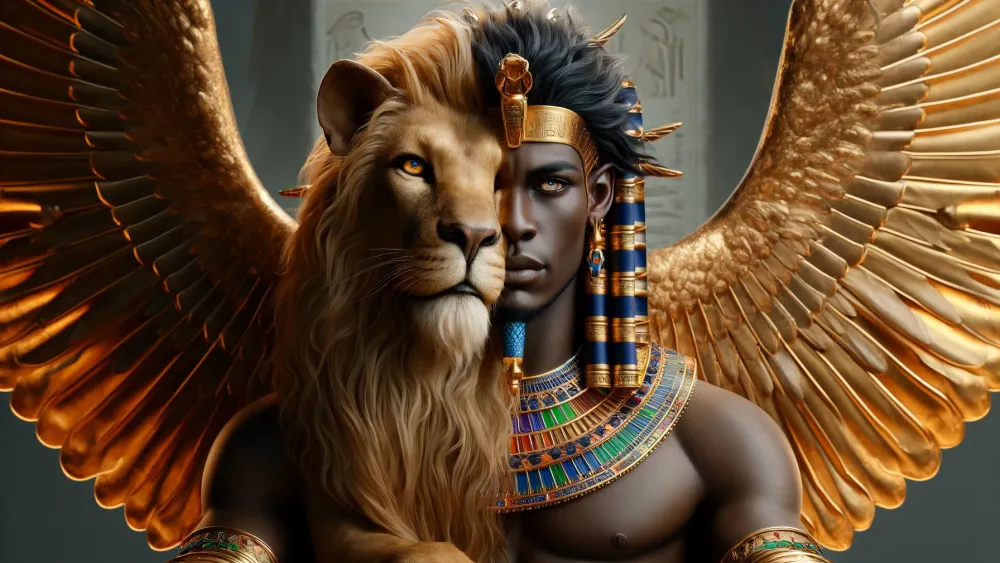
Pantheon of Egyptian Mythology Gods
The pantheon of Egyptian mythology includes many gods and goddesses, each with unique roles. For instance, Ra is the sun god, while Osiris rules the underworld. At the same time, Isis is known for her magic and protective nature. Given that there are so many deities, it can be hard to keep track of them all.
Nonetheless, you can find a comprehensive list of all Egyptian gods to explore their fascinating stories and roles. This list helps you understand how these gods shape ancient Egyptian culture and beliefs.
FAQs
1. Who was Tutu in ancient Egyptian mythology?
Tutu in ancient Egyptian mythology was a protective deity often depicted as a sphinx, known for guarding dreams and slaying demons.
2. What are the main symbols associated with Tutu?
The main symbols associated with Tutu include the sphinx, which represents his protective and powerful nature.
3. How was Tutu worshipped in ancient Egypt?
Tutu was worshipped in ancient Egypt through rituals, prayers, and offerings dedicated to invoking his protection and favor.
4. What is the significance of Tutu as a sphinx?
The significance of Tutu as a sphinx lies in his role as a powerful guardian and protector, embodying both strength and wisdom.

